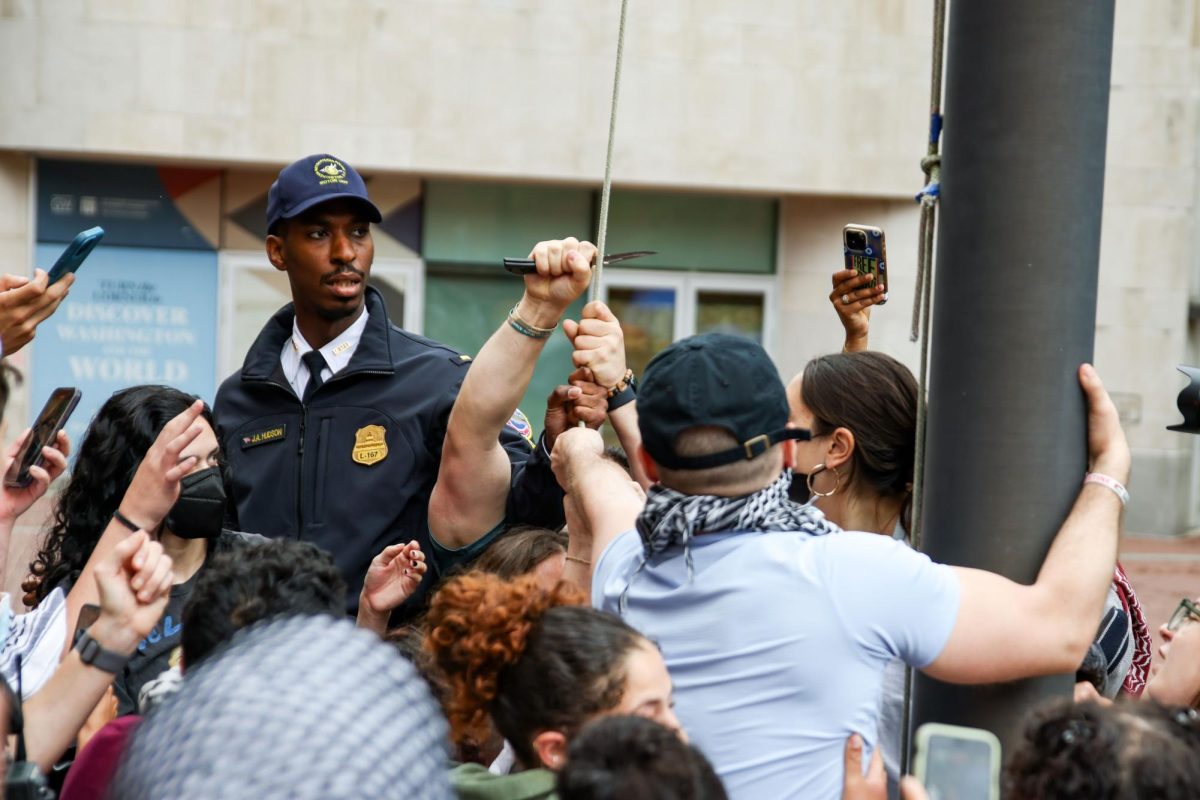A “mid-life crisis” in the School of Engineering and Applied Science spurred two seniors to write a 30-page memo to SEAS faculty members detailing what they see as the problems that plague the school.
“Our purpose in writing this manifesto is not to gripe about the shortcomings of our educational experience at SEAS, but to reinvigorate an element inside each member of our faculty,” Vijay Vanguri and Engineers’ Council President Sergio Yanes write in the memo, which was distributed to full-time engineering professors March 11.
“That element is one of pleasure and intrigue and it draws upon the common interest hopefully shared by our entire faculty: a passion for engineering education.”
The students’ memo is the most recent twist in a volatile year for SEAS. In October, GW Vice President for Academic Affairs Donald Lehman ordered a reorganization of the engineering school that will split and recombine the school’s academic departments, reassign some faculty members and redistribute office space.
The shakeup sparked derision from many faculty members who said they were not consulted about the changes.
The reorganization is just one of the topics Vanguri and Yanes address in the memo, noting that administrators hope the new structure will boost the school’s enrollment and financial prospects, “as if a new coat of paint will fix the engine.”
Among the problems in the engineering school, Vanguri and Yanes write, are apathetic students and faculty with little commitment to SEAS, and no motivation or focus.
“(A)pathy pervades every organizational level in the school, including the faculty, the administration, the alumni and the student body,” Yanes writes in the “State of the School” section that opens the report
“Every level has lost its focus and forgotten the goal of the institution: to provide a top engineering education. In SEAS, there exists a lack of enthusiasm for education,” Yanes writes. Yanes was out of town and unavailable for comment.
Vanguri said students and faculty members have responded positively to the document, which he said echoes underlying sentiments in SEAS.
“A lot of people have related it to Jerry Maguire, sort of like his mission statement,” Vanguri said.
Computer science Professor Bhagi Narahari said the report outlines in specific terms what many faculty members have known for a long time – that morale is down and frustration is up.
“A lot of us agree with (the memo). I hate to say this, but it’s not new,” said Narahari, whose department will split from electrical engineering in the reorganization. “It’s nice that it’s been put in a sort of official form. Quite a few faculty members are impressed with the work the students put in on this.”
Interim Dean Thomas Mazzuchi said he meets with Engineers’ Council officers weekly and has heard the concerns addressed in the memo.
In the document, Vanguri and Yanes stressed the need to hire a permanent dean immediately and pointed out that deans who were SEAS faculty members first have opinions that “have been shaped by previous involvement in the problems of the school.”
“New leadership and ideas, both on the school and department levels, are fundamental for our future progress,” the students write. “Administrators must be leaders external to the institution, without the job security and preconceptions of the faculty. Progress cannot be achieved through the perpetual use of old ideas.”
“Some of the things they address have merit,” Mazzuchi said. “But some of their solutions, like having a dean with no ties to the faculty, just can’t happen. They’re right in some ways, though.”
The memo offers more than just a list of problems. Vanguri and Yanes list nine areas of improvement to spark “meaningful, constructive change” in SEAS. They suggest the school “foster a sense of community across all levels of the institution . convince students that they are engineers . and instill a solid grasp of the fundamentals” (see graphic).
“Many concrete ideas are contained in the nine points of improvement, but we must not ignore the necessity of the intangible concept of enthusiasm,” the students write. “We are certain that a united, enthusiastic effort can revive SEAS from its mid-life crisis . Let us challenge ourselves to provide a quality engineering education for the coming millennium.”
For students and faculty in SEAS, it has been a rough year. In an Oct. 2 memo to engineering school faculty and staff, Lehman called for the a new structure for SEAS to be implemented by July 1, labeling the school’s academic and financial future “uncertain.”
Lehman’s call for an overhaul of the school’s infrastructure set faculty members and administrators to work reassigning faculty, developing strategic plans and charting financial frameworks for their reorganized departments.
But the reorganization, which Mazzuchi said is still on track to be completed this summer, riled many faculty, who felt the plan was made with little input from the school.
The computer science department’s Narahari said the slip in morale has dampened enthusiasm for many of SEAS’s major goals.
“Morale is quite down this year in SEAS, and that has had a lot of impact on faculty’s research, their teaching and the curriculum,” he said. “In the long term, it’s not all negative, but it’s taken a lot of the faculty’s time.
“A lot of people have just put way too much time in on the reorganization. It’s sapped people’s energy,” Narahari said.
Mazzuchi said faculty members have warmed up to the plan because many have seen it as “a chance to say `let’s do something totally new.’ “
But Narahari said many faculty members’ reservations about the reorganization rest in their concern about the amount of resources the University will allocate.
“The problem is resources,” he said. “It’s frustrating not knowing whether we’re going to get the resources we’ve asked for. If it’s just a reshuffling of faculty, that’s not enough.”
For instance, Narahari said faculty members in his department need to be retrained so they can continue to update the curriculum in the ever-changing computer science field. But with only nine or 10 faculty members available each semester to teach more than 400 students, Narahari said it’s been almost impossible to retrain professors. And he said the most junior faculty members were hired nearly 10 years ago.
“There is a disconnect between SEAS and the University,” Narahari said. “There needs to be more give and take between them. I’m hoping we can enter a better era of communication.”
Mazzuchi agreed that it is important for faculty and staff to feel administrators are backing them up.
“If faculty members feel the support from the University, they’ll be happy,” he said.
Narahari said he is optimistic that SEAS is on its way to a bright future, but not without the resources faculty members have requested.
“The changes that have been put in place plus the resources some us have requested can change the future of the school,” he said. “We’re half a step from becoming the best undergraduate engineering school in the area.
“There’s a fair degree of optimism, which I hope does not turn into cynicism, which could happen if we don’t get the resources we need.”
Points of improvement in SEASas suggested in “Common Sense: The Mid-Life Crisis in the School of Engineering and Applied Science” by Vijay Vanguri and Sergio Yanes
1. Foster a sense of community across all levels of the institution
2. Foster a sense of community within each level of the institution
3. Consistently establish the credibility of the professor as a teacher
4. Convince students they are engineers
5. Limit the amount of didactic teaching
6. Instill a solid grasp of the fundamentals
7. Replace competitive evaluation with criterion-based testing
8. Encourage breadth of study through extra-curricular experiences
9. Perpetually compare the system against the ideal system







